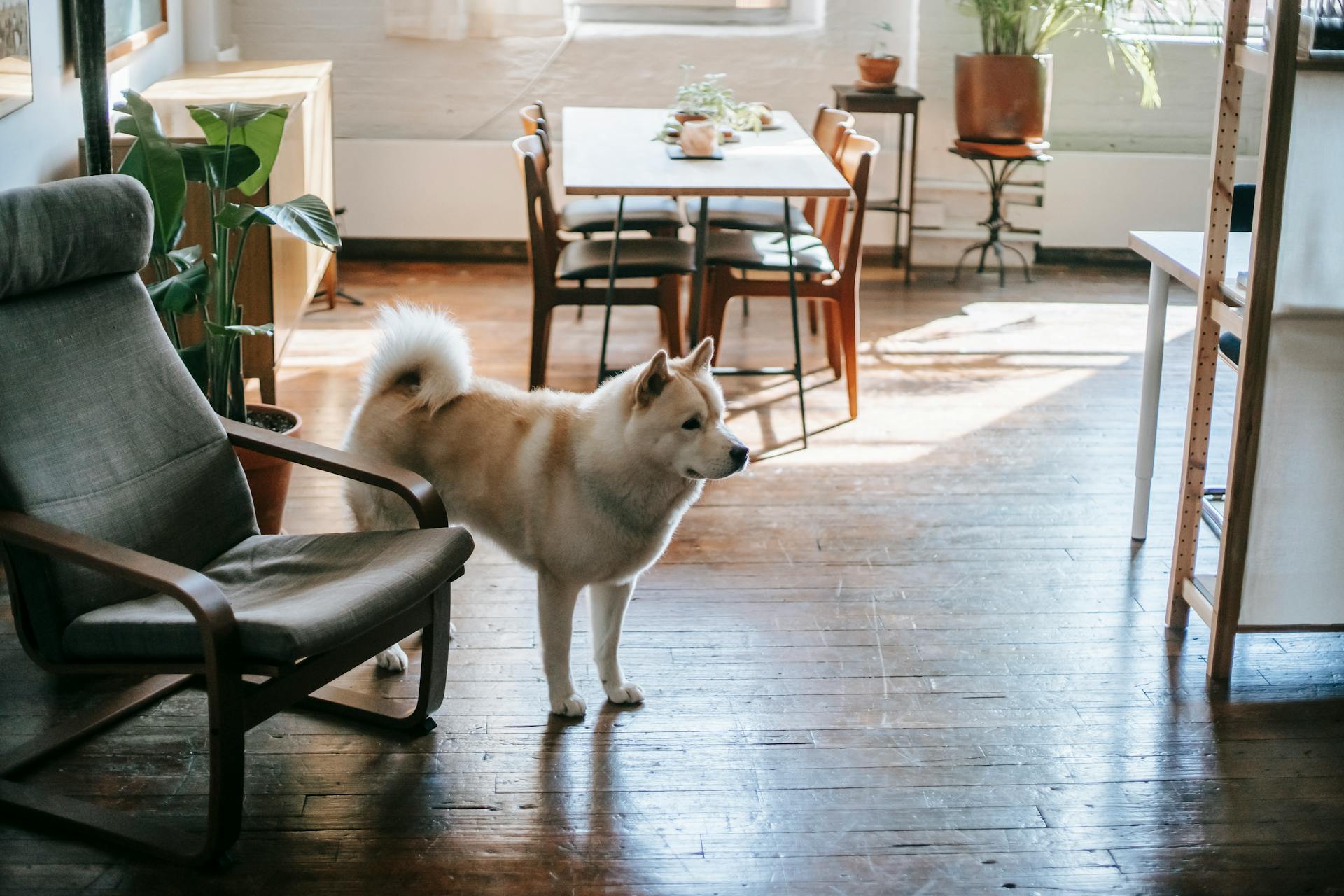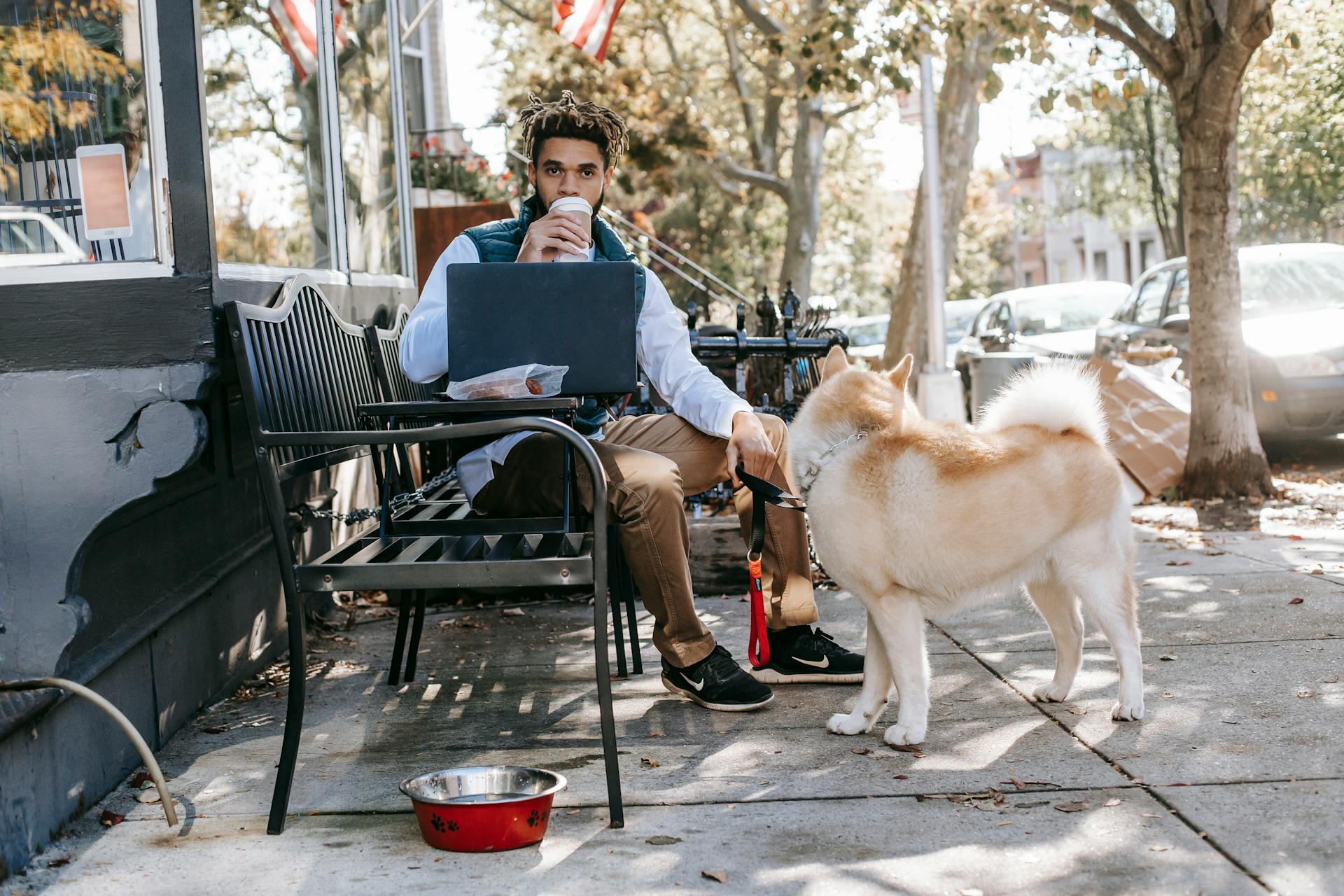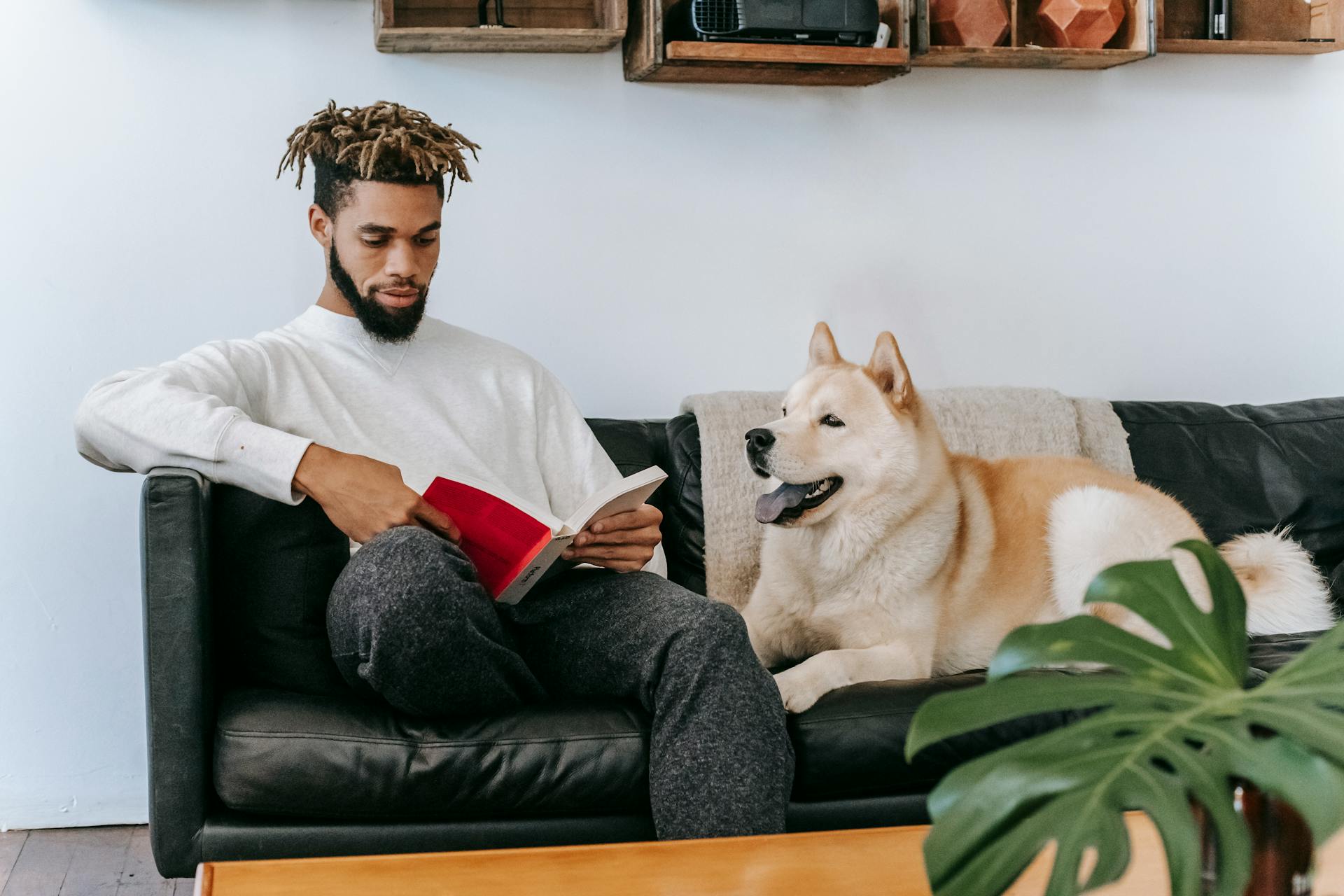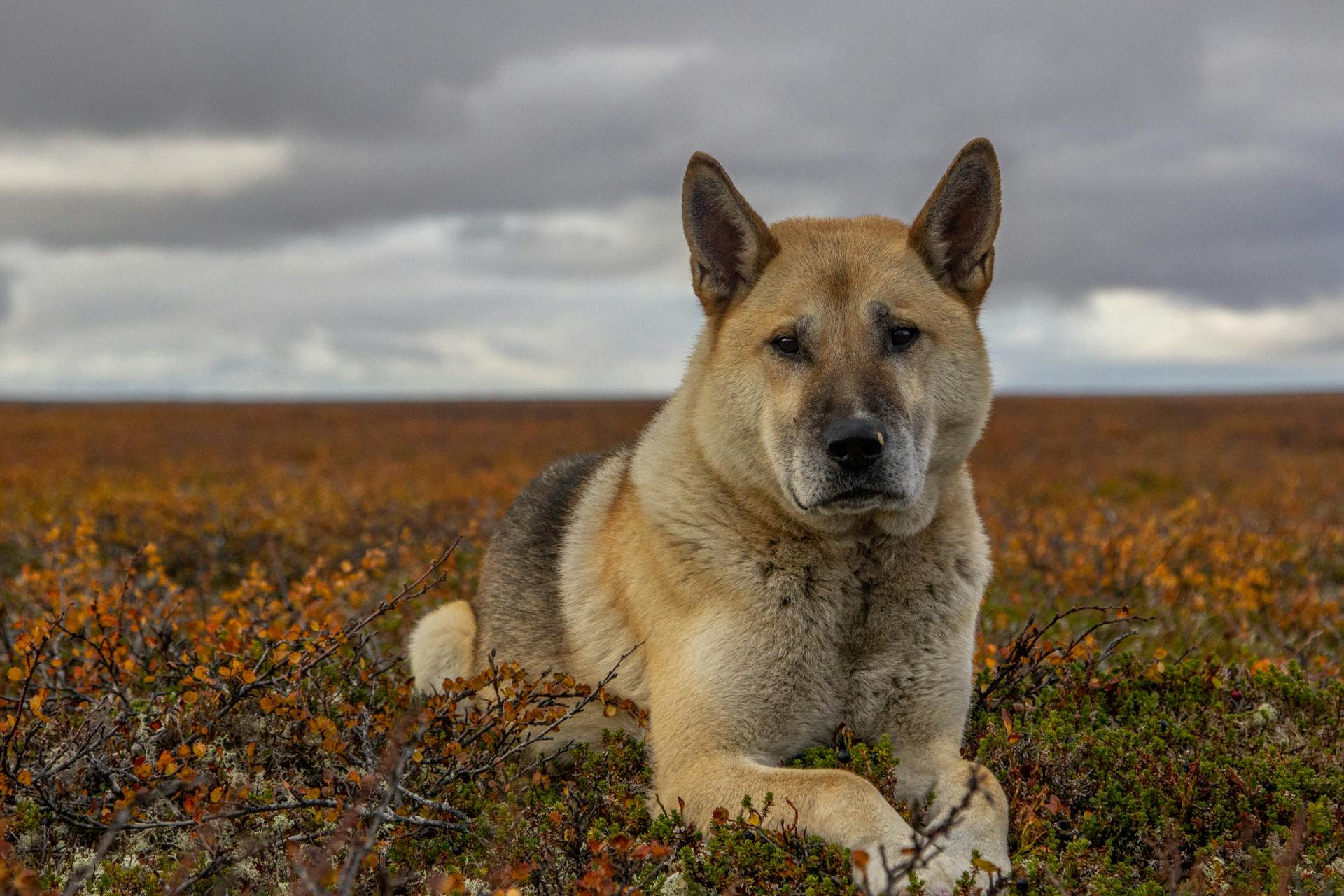
The Akita dog, known for its striking black and white coat, is a loyal and loving companion. They are a large breed of dog that originated in Japan.
Akitas are naturally protective of their families and can be wary of strangers, making them excellent watchdogs. Their independent nature requires early socialization to prevent aggression.
Their thick double coat requires regular grooming to prevent matting and tangling. Brushing their coat 2-3 times a week is essential to keep them looking their best.
Physical Characteristics
The Akita dog is a majestic breed with a sturdy build and a thick coat. They come in a variety of colors, including black and white.
Their average weight is around 110 pounds for males and 80 pounds for females, with males reaching a height of 26-28 inches and females reaching 24-26 inches. Their bodies are muscular and slightly longer than they're tall, with straight and strong legs.
Akitas have broad chests and necks, along with large heads and short muzzles. Their eyes are small and deep-set, while their ears are erect. The tail is full and curled over the body.
Their coat is short to medium in length and dense, with a thick and soft undercoat that makes them well-suited to colder climates. The colors of the Akita dogs include black, fawn, white, red, brown, and several other variations.
Here are the possible coat colors of an Akita dog:
- Black
- Fawn
- White
- Red
- Brown
- Brown Brindle
- Red Brindle
- Fawn Brindle
- Black, Brown Undercoat
- Black, Silver Undercoat
- Black, Red Undercoat
- Black, Fawn Undercoat
- Brown, Black Overlay
- Fawn, Black Overlay
- Red, Black Overlay
- Silver, Black Overlay
- White, Red Shading
- Silver
- Black Brindle
- Silver Brindle
Akitas also have well-defined markings across the body, and some members of the breed have a mask on their face that highlights their intelligent eyes.
Temperament and Behavior
The Akita dog black and white is a unique breed that requires careful consideration before bringing one home. They can be excellent family dogs, especially if trained early and consistently.
Akitas are naturally protective of their families and can be aloof towards strangers. They bond closely with their owners and might get jealous if too much attention is given to another dog. They're happiest as the house's only fur child.
However, with proper socialization, Akitas can learn to tolerate other animals and even live alongside household cats and dogs. But, introducing them to new pets in puppyhood is crucial for a smooth transition.
For another approach, see: Royalty Akitas
Akitas can be quite possessive of their toys or food, so it's essential to establish clear boundaries and rules. They're not always open to playing, especially with small children, which makes them a less-than-ideal choice for families with tiny tots.
But, with patience, consistency, and early training, Akitas can learn to behave around kids and make excellent family pets. They're fiercely independent and can be stubborn, so first-time pet owners might find them challenging to manage.
If you're up for the challenge, Akitas can be a sweet and loving addition to your home. Just remember, they're not the best fit for every household, especially those with small children or multiple pets.
Recommended read: Small White Poodle Dog
Living Needs
Akitas love spending time outside, and a fenced yard where they can roam and sniff is ideal.
They live for cold weather, and when it comes, they'll zoom around in the snow, eating it and rolling around to their hearts' content.
They have slightly webbed toes that help them walk on snowy drifts.
Akitas are relatively quiet, and barking usually isn't an issue unless the dog is alerting its family to a visitor or something unfamiliar.
They have a strong prey drive, so they should always be on-leash and under watchful eyes when outside.
Here are some daily exercise tips for Akitas:
- Get them out for at least two walks daily, with each walk lasting between 20 and 25 minutes.
- Give them plenty of time to run around outside.
- Play with them to encourage them to keep moving as much as possible.
Care and Health
The Akita is a relatively low-maintenance breed when it comes to grooming, but they do require regular brushing to prevent matting and tangling of their thick coats.
To keep your Akita happy and healthy, make sure to provide them with moderate exercise, such as daily jogs or long walks, to prevent weight gain and boredom.
Regular nail trimming, teeth brushing, and potty training are also essential for an Akita's overall well-being. Akitas are known to be easy to potty train, but consistency and positive reinforcement are key.
Here are some common health issues that can affect Akitas:
- Gastric dilatation-volvulus (GDV), also known as bloat, which can be prevented with a surgery called gastropexy.
- Hip dysplasia, a congenital condition that can lead to arthritis.
- Hypothyroidism, an underactive thyroid gland that can cause skin problems and weight gain.
- Eye problems, including inherited conditions such as canine cataracts and multifocal retinal dysplasia.
Overall, Akitas are a relatively healthy breed, but regular veterinary care and monitoring can help prevent or catch these issues early on.
Care
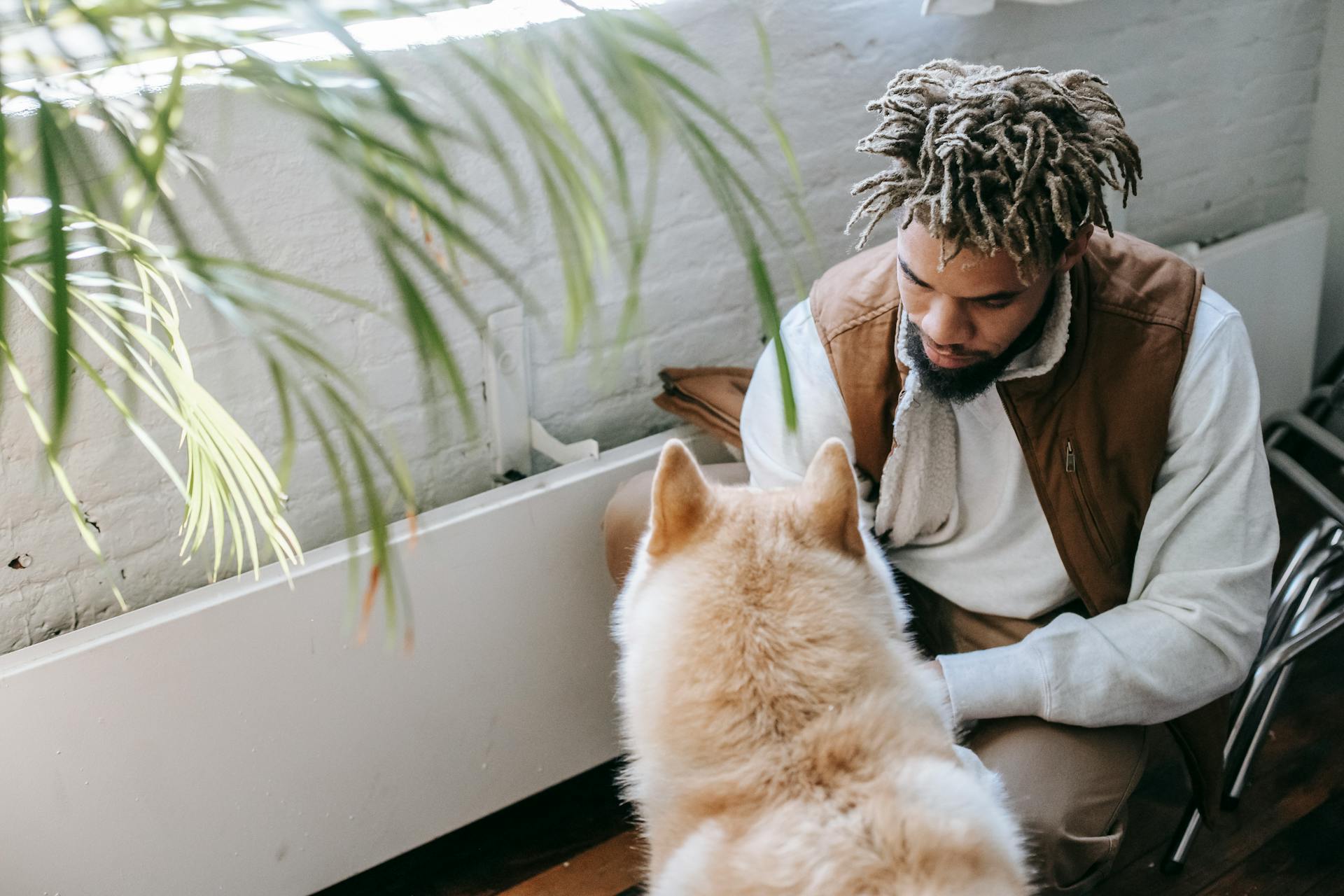
The Akita's grooming needs can be a challenge, especially if your furry friend loves spending time outdoors. Regular brushing and grooming are a must to keep their coat clean and odorless.
Akitas are known for their minimal shedding throughout the year, but be prepared for a massive shedding session when warm weather hits, often referred to as coat blowing. This can cover your entire house, so be sure to have a plan in place to manage the mess.
Regular nail trimming and teeth brushing are also crucial for an Akita's overall health and well-being. These tasks should become a regular part of your dog's routine to prevent any potential issues.
Exercise is also essential for Akitas, requiring moderate physical activity to stay happy and healthy. If your Akita isn't getting enough exercise, a daily jog or long walk will suffice to keep them mentally and physically stimulated.
If your Akita is not getting enough physical activity, they can quickly gain weight, so it's essential to monitor their food intake and ensure they're getting enough exercise. A sedentary lifestyle can lead to obesity, so be sure to keep your Akita active.
Training should start early and be consistent, as Akitas can be strong-willed and independent-minded. Positive reinforcement and calmness are key to successful training, and it's essential to start training as soon as possible to avoid any behavioral issues.
Health
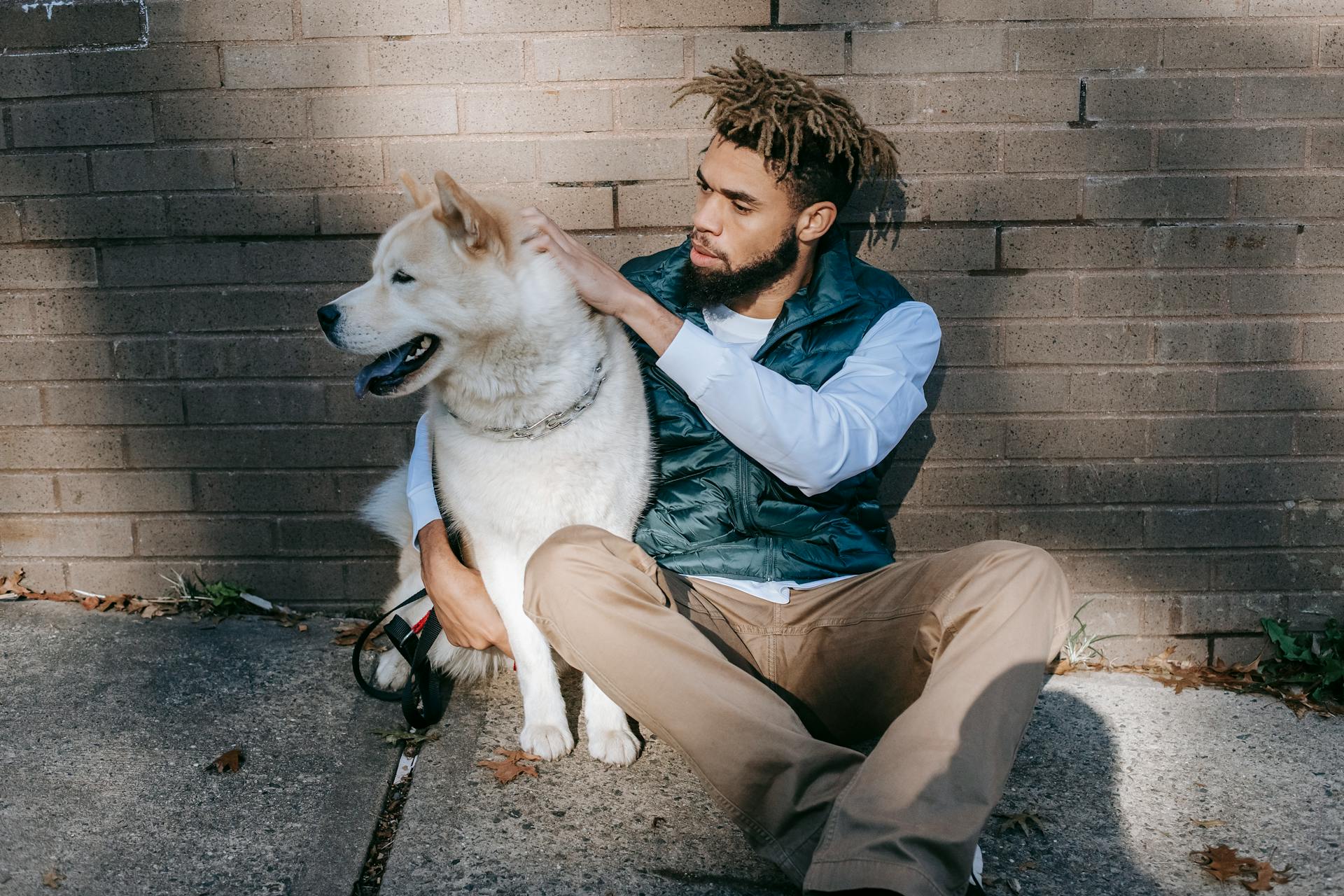
Akita owners should be aware of the breed's common health issues.
The Akita's lifespan is relatively long, ranging from 10-13 years, but they can be prone to certain health conditions. Hip dysplasia and arthritis are two conditions that can affect Akitas, causing hip joint issues and pain.
Gastric dilatation-volvulus, also known as bloat, is a life-threatening emergency that can occur when the stomach twists and cuts off blood supply. This can happen when dogs eat or drink too quickly, and it's essential to prevent it.
Hypothyroidism is another condition that can affect Akitas, causing issues with skin, weight, and energy levels. Eye problems, including canine cataracts and multifocal retinal dysplasia, can also occur.
Some Akitas may be prone to sebaceous adenitis, an autoimmune skin disease that causes hair loss on the back and head. Obesity is also a concern, as it can exacerbate other health issues.
Here are some common health problems that can affect Akitas:
- Gastric dilatation-volvulus (bloat)
- Hip dysplasia
- Sebaceous adenitis (autoimmune skin disease)
- Hypothyroidism
- Eye problems (canine cataracts, multifocal retinal dysplasia, canine glaucoma, progressive retinal atrophy, entropion, and ectropion)
It's crucial to work with a reputable breeder and keep your Akita healthy through regular medical care. Many owners choose to buy Akita pet insurance to ensure affordable coverage for their pet.
Average Lifespan
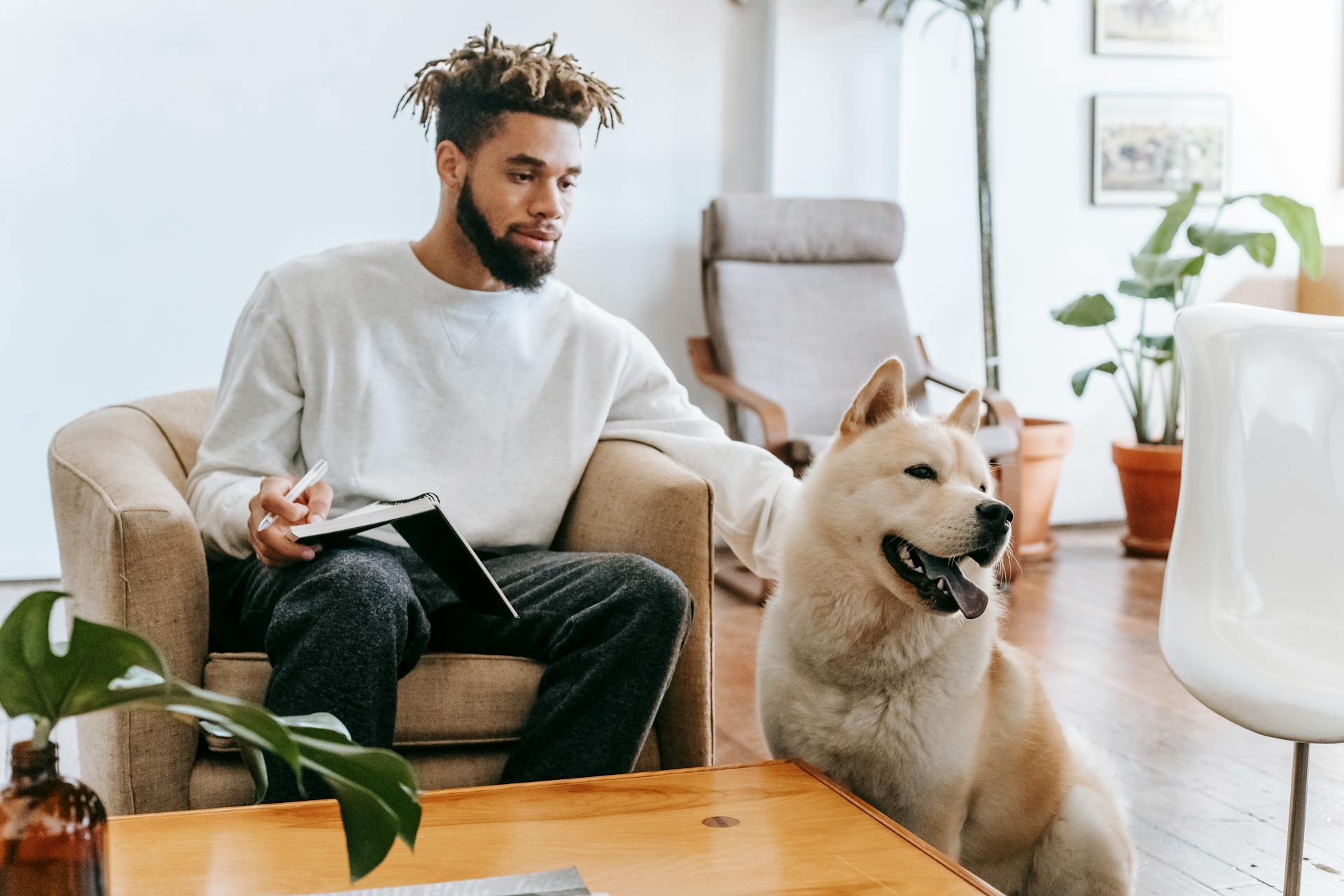
The average lifespan of an Akita is a significant factor to consider when deciding to bring one home. They range from 10 to 13 years.
Proper healthcare is crucial to ensure your Akita lives a long and healthy life. If well cared for, Akitas will show signs of sickness only when they've reached senior age.
Regular exercise is also essential for Akitas to stay healthy.
Grooming and Diet
Akitas are clean dogs that don't require extensive grooming, but they do need regular brushing to keep their thick double coat looking its best. Brushing at least once a week should suffice, but they shed profusely when the seasons change.
During these times, they need more frequent grooming to get rid of the dead coat. Be prepared for a lot of hair everywhere.
To keep your Akita healthy and happy, feed them a high-quality, low-calorie diet that prevents them from growing too fast. Adult Akitas need three to five cups of dry food distributed into two meals.
Grooming Requirements
Akitas are clean dogs that don't require extensive grooming, but they do need regular brushing to keep their thick double coat looking its best.
Brushing at least once a week is sufficient for most of the year, but during seasonal changes, they shed profusely and need more frequent grooming to get rid of the dead coat.
Their teeth should be brushed often, and their nails should be trimmed on a regular basis.
You'll also need to brush their teeth daily to keep up with their oral hygiene, and keep an eye on their nails and trim them as needed.
Brushing a few times a week is enough for Akitas throughout most of the year, but during their "blow-coat" season, daily brushing is necessary to deal with the excess hair.
Food & Diet
Akita puppies grow rapidly, which makes them susceptible to bone disorders, so a high-quality, low-calorie diet is essential.
Adult Akitas should be fed three to five cups of dry food distributed into two meals to prevent overeating.
Some Akitas can get overweight, so it's crucial to monitor their calorie intake and discuss any special needs with your vet.
These pets can be food-possessive, so it's best to feed them away from kids or other animals.
Smaller Akitas typically need 4 cups of high-quality kibble daily, while larger Akitas need 5.75 cups of kibble daily.
Make sure to provide your Akita with clean, fresh water at all times.
Training and Compatibility
Training an Akita requires consistent training from an early age to address their independent and headstrong nature. Akitas are intelligent dogs, but they can become bored with repetitive training.
Early socialization is crucial to help your Akita learn not to perceive strangers as a threat. This is especially important to prevent potential aggression issues. Akitas are generally not highly active and require moderate exercise, such as a brisk walk or jog once a day, to stay in good shape.
Getting Started in Dog Sports
Getting started in dog sports can be an exciting and rewarding experience for both you and your furry friend. Intro to Dog Sports is a great place to begin, as it provides a solid foundation for understanding the basics of dog sports.
If you're interested in competing with a mixed breed dog, you can enroll them as Canine Partners, which is a great way to get started in dog sports. Enrolling your mixed breed dog can open up new opportunities for you and your dog to participate in dog sports.
You'll likely encounter various titles and abbreviations in dog sports, so it's essential to familiarize yourself with them. Titles & Abbreviations is a section that can help you make sense of it all.
Considering the numerous dog sports out there, it can be challenging to decide which one to pursue with your dog. Which Sport Should You Do With Your Dog? is a section that can help you make an informed decision based on your dog's breed, age, and personality.
You might like: Akita Ken Dog
To get started in dog training, you'll need to invest time and effort into teaching your dog basic obedience commands. Get Started in Dog Training is a section that can guide you through the process.
If you're interested in participating in dog sports remotely, Virtual Dog Sports & Events is a great option. You can participate in dog sports from the comfort of your own home, which is perfect for those who may have mobility issues or prefer not to travel.
Take a look at this: Japanese Akita Training
Training
Training an Akita requires consistent effort from an early age. They're intelligent dogs, but also quite independent and headstrong, which can make them difficult to control.
Consistent training is essential due to their size and energy. A brisk walk or jog once a day should be enough to keep them in good shape.
Akitas can easily become bored with training if it's not challenging enough. They thrive when given jobs to do and enjoy playing.
Early socialization is very important for Akitas to learn not to perceive strangers as a threat.
Pet Compatibility
The Akita is a breed that requires careful consideration when it comes to other pets in the home. They usually don't get along well with other pets, whether it's dogs or cats.
Proper socialization can help, but it's rare for an Akita to live harmoniously with other pets unless the others accept the Akita as the top dog.
Origin & History
The Akita's origin story begins in the 17th century in the Akita prefecture in Japan.
The breed's lineage can be traced back to the Jōmon Period, a time spanning from 14,000 to 300 B.C. This ancient history is a testament to the breed's enduring legacy.
Akita dogs were originally bred as strong, hard-working hunting dogs, but their loyalty and affectionate nature soon made them beloved family companions.
In 1931, the Japanese government named the Akita a national treasure, and in 1937, Helen Keller brought the first Akita to the U.S.
The breed's spiritual significance in Japan is still celebrated today, with Akita dogs seen as symbols of good health and good luck.
After World War II, American servicemen brought Akita dogs back to the U.S., helping to popularize the breed.
The Akita was officially recognized by the American Kennel Club in 1972, cementing its place as a beloved breed around the world.
Here's an interesting read: American Eskimo Dog Black and White
Frequently Asked Questions
What is the price of Akita dog black and white?
The price of an Akita puppy can range from $1,000 to $3,000, depending on factors like health and temperament. Prices may vary depending on the breeder and puppy characteristics.
What are the rarest Akita colors?
The rarest Akita colors include black, sesame, and silver, with black Akitas being particularly uncommon. These unique colors make them stand out from the more common Akita coat colors.
Featured Images: pexels.com
